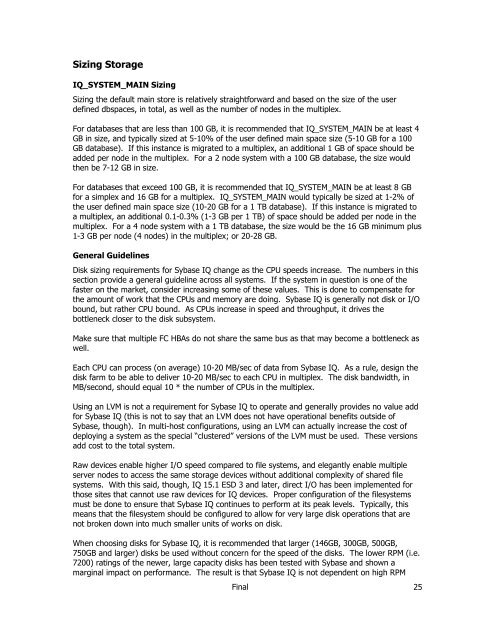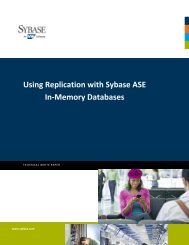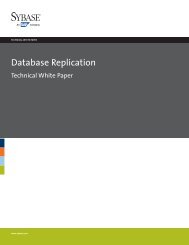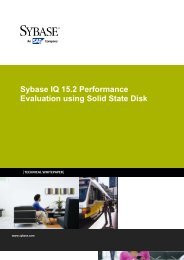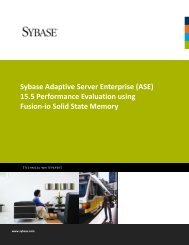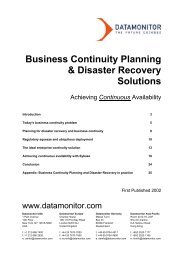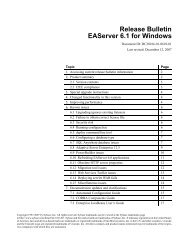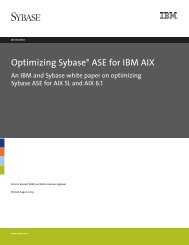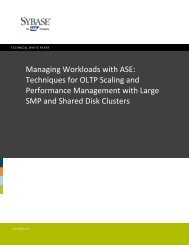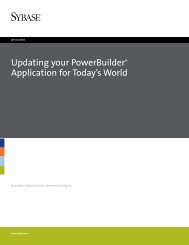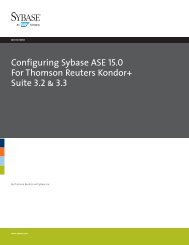A Practical Hardware Sizing Guide for Sybase IQ
A Practical Hardware Sizing Guide for Sybase IQ
A Practical Hardware Sizing Guide for Sybase IQ
Create successful ePaper yourself
Turn your PDF publications into a flip-book with our unique Google optimized e-Paper software.
<strong>Sizing</strong> Storage<br />
<strong>IQ</strong>_SYSTEM_MAIN <strong>Sizing</strong><br />
<strong>Sizing</strong> the default main store is relatively straight<strong>for</strong>ward and based on the size of the user<br />
defined dbspaces, in total, as well as the number of nodes in the multiplex.<br />
For databases that are less than 100 GB, it is recommended that <strong>IQ</strong>_SYSTEM_MAIN be at least 4<br />
GB in size, and typically sized at 5-10% of the user defined main space size (5-10 GB <strong>for</strong> a 100<br />
GB database). If this instance is migrated to a multiplex, an additional 1 GB of space should be<br />
added per node in the multiplex. For a 2 node system with a 100 GB database, the size would<br />
then be 7-12 GB in size.<br />
For databases that exceed 100 GB, it is recommended that <strong>IQ</strong>_SYSTEM_MAIN be at least 8 GB<br />
<strong>for</strong> a simplex and 16 GB <strong>for</strong> a multiplex. <strong>IQ</strong>_SYSTEM_MAIN would typically be sized at 1-2% of<br />
the user defined main space size (10-20 GB <strong>for</strong> a 1 TB database). If this instance is migrated to<br />
a multiplex, an additional 0.1-0.3% (1-3 GB per 1 TB) of space should be added per node in the<br />
multiplex. For a 4 node system with a 1 TB database, the size would be the 16 GB minimum plus<br />
1-3 GB per node (4 nodes) in the multiplex; or 20-28 GB.<br />
General <strong>Guide</strong>lines<br />
Disk sizing requirements <strong>for</strong> <strong>Sybase</strong> <strong>IQ</strong> change as the CPU speeds increase. The numbers in this<br />
section provide a general guideline across all systems. If the system in question is one of the<br />
faster on the market, consider increasing some of these values. This is done to compensate <strong>for</strong><br />
the amount of work that the CPUs and memory are doing. <strong>Sybase</strong> <strong>IQ</strong> is generally not disk or I/O<br />
bound, but rather CPU bound. As CPUs increase in speed and throughput, it drives the<br />
bottleneck closer to the disk subsystem.<br />
Make sure that multiple FC HBAs do not share the same bus as that may become a bottleneck as<br />
well.<br />
Each CPU can process (on average) 10-20 MB/sec of data from <strong>Sybase</strong> <strong>IQ</strong>. As a rule, design the<br />
disk farm to be able to deliver 10-20 MB/sec to each CPU in multiplex. The disk bandwidth, in<br />
MB/second, should equal 10 * the number of CPUs in the multiplex.<br />
Using an LVM is not a requirement <strong>for</strong> <strong>Sybase</strong> <strong>IQ</strong> to operate and generally provides no value add<br />
<strong>for</strong> <strong>Sybase</strong> <strong>IQ</strong> (this is not to say that an LVM does not have operational benefits outside of<br />
<strong>Sybase</strong>, though). In multi-host configurations, using an LVM can actually increase the cost of<br />
deploying a system as the special “clustered” versions of the LVM must be used. These versions<br />
add cost to the total system.<br />
Raw devices enable higher I/O speed compared to file systems, and elegantly enable multiple<br />
server nodes to access the same storage devices without additional complexity of shared file<br />
systems. With this said, though, <strong>IQ</strong> 15.1 ESD 3 and later, direct I/O has been implemented <strong>for</strong><br />
those sites that cannot use raw devices <strong>for</strong> <strong>IQ</strong> devices. Proper configuration of the filesystems<br />
must be done to ensure that <strong>Sybase</strong> <strong>IQ</strong> continues to per<strong>for</strong>m at its peak levels. Typically, this<br />
means that the filesystem should be configured to allow <strong>for</strong> very large disk operations that are<br />
not broken down into much smaller units of works on disk.<br />
When choosing disks <strong>for</strong> <strong>Sybase</strong> <strong>IQ</strong>, it is recommended that larger (146GB, 300GB, 500GB,<br />
750GB and larger) disks be used without concern <strong>for</strong> the speed of the disks. The lower RPM (i.e.<br />
7200) ratings of the newer, large capacity disks has been tested with <strong>Sybase</strong> and shown a<br />
marginal impact on per<strong>for</strong>mance. The result is that <strong>Sybase</strong> <strong>IQ</strong> is not dependent on high RPM<br />
Final<br />
25


